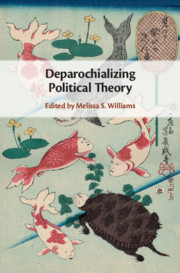Book contents
- Deparochializing Political Theory
- Deparochializing Political Theory
- Copyright page
- Dedication
- Contents
- Tables
- Contributors
- Preface and Acknowledgments
- Note on the Text
- 1 Introduction
- 2 Deparochializing Political Theory and Beyond
- 3 Recentering Political Theory, Revisited
- 4 A Decentralized Republic of Virtue
- 5 Deparochializing Political Theory from the Far Eastern Province
- 6 Is Popular Sovereignty a Useful Myth?
- 7 Authoritarian and Democratic Pathways to Meritocracy in China
- 8 Deparochializing Democratic Theory
- 9 Teaching Comparative Political Thought
- 10 Teaching Philosophy and Political Thought in Southeast Asia
- 11 Why Globalize the Curriculum?
- Index
9 - Teaching Comparative Political Thought
Joys, Pitfall, Strategies, Significance
Published online by Cambridge University Press: 15 March 2020
- Deparochializing Political Theory
- Deparochializing Political Theory
- Copyright page
- Dedication
- Contents
- Tables
- Contributors
- Preface and Acknowledgments
- Note on the Text
- 1 Introduction
- 2 Deparochializing Political Theory and Beyond
- 3 Recentering Political Theory, Revisited
- 4 A Decentralized Republic of Virtue
- 5 Deparochializing Political Theory from the Far Eastern Province
- 6 Is Popular Sovereignty a Useful Myth?
- 7 Authoritarian and Democratic Pathways to Meritocracy in China
- 8 Deparochializing Democratic Theory
- 9 Teaching Comparative Political Thought
- 10 Teaching Philosophy and Political Thought in Southeast Asia
- 11 Why Globalize the Curriculum?
- Index
Summary
This chapter builds on Stephen Salkever’s experience as one of the first political theorists to teach comparatively in a serious and sustained way. This work began in the 1980s with a co-taught course comparing ancient Greek and ancient Chinese texts. For Salkever, comparative teaching is a practice of what he calls liberal education, which aims to foster the habits of mind that sustain curiosity and critical self-reflection. Texts are chosen not as representative of a particular culture or tradition but as exemplars of original thinking that unsettled the self-understandings of their authors’ contemporaries as much as they might unsettle ours. In this chapter, Salkever reflects on the contributions of comparative political theory to “deparochializing” and “provincializing” Western political theory and even liberal education as such. Both ways of construing the tasks of comparative political theory see it as a form of “constructive escape” from our received opinions, which can limit our capacity for political judgment if they are left unexamined. Salkever draws out the implications of this way of understanding comparative political theory as an educational practice, highlighting the importance of juxtaposing contradictory texts within a given tradition (to resist cultural essentialism) as well as finding continuities across traditions.
Keywords
- Type
- Chapter
- Information
- Deparochializing Political Theory , pp. 230 - 253Publisher: Cambridge University PressPrint publication year: 2020



